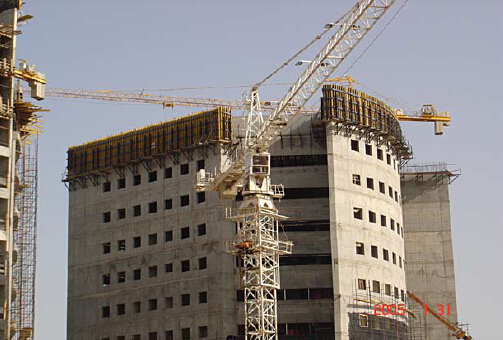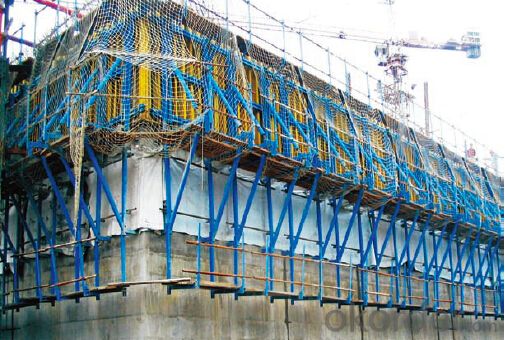Single-Side Climbing Bracket for formwork and scaffolding system
- Loading Port:
- Tianjin
- Payment Terms:
- TT OR LC
- Min Order Qty:
- 50 m²
- Supply Capability:
- 1000 m²/month
OKorder Service Pledge
OKorder Financial Service
You Might Also Like
Single-side Climbing Bracket SCB180:
With CNBM SCB 180 climbing systems, the loads from the fresh concrete pressure are
transferred through the brackets by means of V-strongbacks and compression braces into the
scaffold anchors.
Typical applications for the SCB 180 are dams, locks, cooling towers, pier heads, tunnels, and
bank vaults.
The formwork is simply tilted backwards when striking takes place. The 1.80 m wide bracket
requires only a minimum of space.
Characteristics:
◆ Economical and safe anchoring
The M30/D20 climbing cones have been designed especially for single-sided concreting using
SCB180 in dam construction, and to allow the transfer of high tensile and shear forces into the still
fresh, unreinforced concrete. Without wall-through tie-rods, finished concrete is perfect.
◆ Stable and cost-effective for high loads
generous bracket spacings allow large-area formwork units with optimal utilization of the bearing
capacity. This leads to extremely economical solutions.
◆ Simple and flexible planning
With SCB180 single-sided climbing formwork, circular structures can also be concreted without
undergoing any large planning process. Even use on inclined walls is feasible without any special
measures because additional concrete loads or lifting forces can be safely transferred into the
structure.


- Q: Can steel formwork be used in areas with extreme temperature variations?
- Yes, steel formwork can be used in areas with extreme temperature variations. Steel has a high strength-to-weight ratio and is resistant to temperature changes, making it suitable for use in various conditions. It can withstand both high and low temperatures without structural deformation or deterioration. Additionally, steel formwork provides excellent stability and durability, ensuring that it can withstand the stress caused by extreme temperature fluctuations. However, it is important to consider thermal expansion and contraction effects when using steel formwork in areas with extreme temperature variations, as this may impact the accuracy of the formwork and the final concrete structure. Proper design considerations and installation techniques can help mitigate any potential issues related to temperature variations.
- Q: How does steel formwork handle concrete shrinkage and expansion?
- Steel formwork handles concrete shrinkage and expansion by providing a rigid framework that supports and contains the concrete during the curing process. The steel formwork is designed to withstand the pressure exerted by the concrete, preventing any deformation or cracking that may occur due to shrinkage or expansion. Its strength and durability ensure that the formwork remains intact and stable, effectively managing the dimensional changes of the concrete.
- Q: Are there any specific considerations for using steel formwork in areas with high humidity?
- Yes, there are specific considerations for using steel formwork in areas with high humidity. High humidity can lead to increased moisture absorption by steel formwork, which can result in corrosion. To mitigate this, it is important to use steel formwork that has been properly treated with anti-corrosion coatings or galvanized to provide a protective barrier against moisture. Regular inspection and maintenance of the formwork is also crucial in high humidity areas to identify any signs of corrosion and take appropriate measures to prevent its progression. Additionally, ensuring proper ventilation and airflow around the formwork can help reduce the level of humidity and minimize moisture absorption.
- Q: How does steel formwork handle concrete bleeding and segregation?
- Steel formwork has a reputation for effectively managing concrete bleeding and segregation. Bleeding occurs when water in the concrete mixture rises to the surface, leaving a layer of water on top. Segregation, on the other hand, happens when the solid particles in the concrete mixture separate from the water, causing an uneven distribution. To minimize bleeding and segregation, steel formwork provides a sturdy structure that holds the concrete in place during pouring and curing. The strong construction and tight joints of steel formwork prevent any leaks or seepage, resulting in reduced bleeding. Moreover, steel formwork allows for better control over the placement and compaction of the concrete. The smooth and non-absorbent surface of steel formwork facilitates a uniform distribution of the concrete mixture, minimizing the risk of segregation. Additionally, using steel formwork enables proper vibration and consolidation of the concrete, eliminating any voids or air pockets that could contribute to segregation. Furthermore, steel formwork ensures stability during the curing process, preventing significant movement of the concrete. This stability helps avoid disturbances that could lead to bleeding or segregation. In conclusion, steel formwork is highly effective in managing concrete bleeding and segregation due to its rigid structure, tight joints, smooth surface, and stability. Its use promotes a more consistent and consolidated placement of concrete, resulting in a higher quality finished product.
- Q: Can steel formwork be used for projects with limited formwork transportation options?
- Yes, steel formwork can be used for projects with limited formwork transportation options. Steel formwork is known for its durability, strength, and reusability, making it an ideal choice for projects that require transportation over long distances or difficult terrains. Unlike traditional wood formwork, steel formwork can withstand the rigors of transportation without getting damaged or deformed. Furthermore, steel formwork is lightweight compared to other materials used for formwork, such as concrete or timber, which makes it easier to transport even in areas with limited transportation options. The lightweight nature of steel formwork not only reduces transportation costs but also allows for easier handling and installation on-site. Additionally, steel formwork can be easily disassembled and reassembled, making it suitable for projects that require frequent formwork transportation. The modular design of steel formwork allows for easy transportation and reconfiguration, ensuring that the formwork can be efficiently transported to different project sites as needed. In conclusion, steel formwork is a versatile and practical solution for projects with limited formwork transportation options. Its durability, lightweight nature, and ease of disassembly and reassembly make it a suitable choice for projects that require formwork to be transported over long distances or difficult terrains.
- Q: How does steel formwork handle different concrete segregation tendencies?
- Steel formwork offers a versatile and durable solution for managing various concrete segregation tendencies. Its strength and rigidity enable it to withstand the pressure exerted by fresh concrete during pouring and vibrating. When confronted with concrete that tends to segregate, steel formwork provides crucial support and containment to prevent the separation of aggregates from the cement paste. The smooth and tight surface of steel formwork aids in retaining moisture within the concrete, preventing excessive water loss and subsequent segregation. Additionally, steel formwork can be easily adjusted and reinforced to accommodate different concrete mix designs and placement techniques. This adaptability allows for the creation of formwork systems that minimize the risk of segregation, guaranteeing a uniform and homogeneous concrete structure. Furthermore, steel formwork possesses resistance to warping and deformation, ensuring the maintenance of formwork shape and stability. This characteristic prevents any potential shifting or movement that could contribute to concrete segregation. Moreover, steel formwork can be designed with features like tie rods and braces, which provide extra support and prevent bulging or bowing of the formwork under concrete pressure. This feature is particularly advantageous when dealing with concrete mixtures that have a high tendency to segregate. To summarize, steel formwork effectively manages various concrete segregation tendencies by offering robust support, preventing excessive water loss, and providing flexibility and adjustability to accommodate different mix designs. Its strength and stability guarantee that the formwork retains the necessary shape and integrity to prevent segregation and produce a uniform and high-quality concrete structure.
- Q: How does steel formwork affect the overall stability of the structure?
- Steel formwork can greatly enhance the overall stability of a structure. Its rigid and durable nature provides strong support during the construction process, ensuring that the concrete is poured and cured accurately. This stability prevents any shifting or deformation of the structure, resulting in a more robust and long-lasting building. Additionally, steel formwork allows for precise alignment and dimension control, enabling the structure to meet the required design specifications, resulting in enhanced stability and structural integrity.
- Q: What are the features of the new building template?
- No ne1, long service life. Service life is 3 times the old template.2, low cost. Compared with the original old template, the cost per square meter decreased by 35%.3, strong, firm, high compressive strength. The pressure capacity per square meter is 2 times the old steel formwork.4, once pouring molding, no need to re plastering processing, improve the construction speed, and save construction costs.5, demolition, easy installation.ed to be used again after the molding process. The periphery of the template with plate fixation, and a groove can be inserted, the template is extended.
- Q: How does steel formwork contribute to the overall sustainability of the construction industry?
- There are several ways in which steel formwork contributes to the overall sustainability of the construction industry. Firstly, its durability and long-lasting nature allow for multiple reuses, reducing the need for new formwork materials each time a construction project is undertaken. This, in turn, significantly reduces waste generation during the construction process and minimizes the industry's overall environmental impact. In addition, steel formwork offers a more sustainable alternative to traditional materials like timber. The use of timber often involves cutting down trees, leading to deforestation and habitat destruction. By opting for steel formwork, we can decrease our reliance on timber and contribute to the preservation of forests. Moreover, steel formwork provides greater structural stability and strength compared to other materials. This enables more efficient construction processes and reduces the necessity for additional support structures. Consequently, less material is wasted, energy is conserved, and the overall construction time is shortened, resulting in a more sustainable process. Furthermore, steel formwork exhibits exceptional resistance to weather conditions, corrosion, and fire. This ensures the longevity of buildings, thus reducing the need for frequent repairs or replacements. By utilizing steel formwork, we can construct structures with extended lifespans, leading to reduced resource consumption and waste generation over time. Lastly, steel formwork is recyclable. At the end of its lifecycle, it can be easily melted down and repurposed for other applications. This diminishes the demand for new steel production, conserves natural resources, and lowers energy consumption. To sum up, steel formwork's durability, reusability, resistance to weather conditions, and recyclability all contribute to the overall sustainability of the construction industry. By minimizing waste generation, deforestation, energy consumption, and resource depletion, its use proves to be an environmentally-friendly choice for construction projects.
- Q: How does steel formwork affect the overall construction site waste recycling?
- Steel formwork can have a significant impact on the overall construction site waste recycling. Unlike traditional timber formwork, steel formwork is more durable and can be reused multiple times. This reduces the amount of waste generated on the construction site as there is less need for new formwork materials to be produced and disposed of. Steel formwork is also easier to clean and maintain, further extending its lifespan and reducing the need for replacement. This not only reduces waste but also saves costs associated with purchasing new formwork materials for each construction project. Additionally, steel formwork is highly recyclable. At the end of its life cycle, steel formwork can be recycled and used to produce new steel products, reducing the demand for virgin materials and minimizing the environmental impact. By using steel formwork, construction sites can significantly reduce their waste generation and contribute to a more sustainable construction industry. This not only benefits the environment but also promotes a more efficient and cost-effective approach to construction.
Send your message to us
Single-Side Climbing Bracket for formwork and scaffolding system
- Loading Port:
- Tianjin
- Payment Terms:
- TT OR LC
- Min Order Qty:
- 50 m²
- Supply Capability:
- 1000 m²/month
OKorder Service Pledge
OKorder Financial Service
Similar products
Hot products
Hot Searches



















